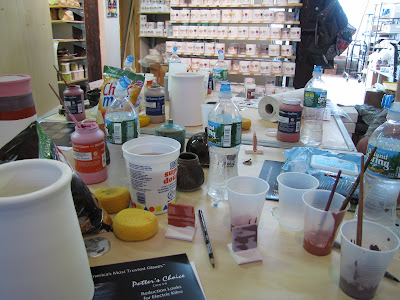 |
| Stained-Glass Lantern at Disneyland |
Hey there! I spent the last
week in California and had a great time. It was primarily to visit
friends, but it's impossible for me to not partake in at least a
little art. So I thought I'd talk a little about the stuff I saw in
California.
 |
| Lantern and bougainvilleas. |
Firstly I went to
Disneyland with a friend. Growing up at Disneyland made for an
interesting childhood and even as an adult I find I still discover
new things when I go. At
Ranchodel Zocalo Restaurante you can find your lunch, but I enjoy eating
there more for the atmosphere. The Mexican food restaurant is
designed to look like a villa or bungalo that could be found in
Mexico or California in days past. This quaint (I'm sure how I feel
about using that word) bougainvillea-covered eating area is decorated with glass lanterns and beautiful tile work. I have stood in front of the door
way for at least 15 minutes before, just admiring the stained-glass
entryway. Even if you decide to eat somewhere else, but you love
glass and tile work you should stop in to just look.
 |
| Levitated Mass |
I
also stopped by for a quick trip to LACMA (Los Angeles County Museum
of Art) to view and experience the work entitled Levitated Mass. The
piece consists of two main features: a walk way and a giant rock.
Now it doesn't seem much but we're talking a GIANT rock. The rock
was located in Riverside and was shipped into LA for the exhibit. A
piece over 3 decades in the making. So I have a question for you and
it's mostly about modern art. Do you think this rock is art? How is
it art? Is it art because you can experience it or relate to it in
some way? What do you think the statement is here? I wont go into
what I think, but I would like a discussion on it. Even in ceramics
and glass we face the same questions. What do you try and make your
pieces say? Or are the just something pretty to look at?
 |
| The view from above the walkway. |
If
you're interested in tile or glass work check out some of these
things:









.jpg)